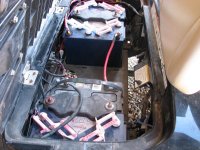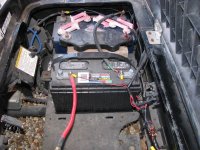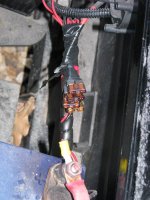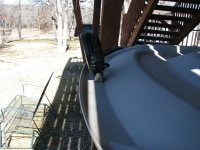Jinman , it's time to go shopping . New batteries , $ 600.00 , your brother priceless .
Kevin, I think that's a bit of a stretch in comparison, but I agree with the sentiment in many regards.

I would say it's something more like: New batteries - $600. Wasting money on something I don't need - senseless. So, I went to Walmart and bought their largest marine battery the
Everstart Maxx Group 29 deep cycle. While it is not the original cart battery, it has about 3/4 the amp-hour rating and is only $99 with a 2-year guarantee. I don't have to search and dig through golf cart specialty stores or other remote locations if I need a warranty replacement or another similar battery. I can buy these batteries at any Walmart. Frankly, I was tempted to replace all four batteries with four of these and tell my brother he'll have to charge a little more often. With a working battery monitor, it will tell him when he needs to charge. Everything I read about these marine batteries was good with rare exception.
So, I bought and installed the Everstart Maxx battery with the three remaining US batteries. The only problem was the battery clamp since this battery is about 1-1/2" shorter than the US Battery. I just trimmed a piece of wood and slid it under the hold-down. It worked perfectly. I didn't take photos of the batteries, but I will and post them later. With the batteries installed, the battery monitor showed full power and I set off see how the cart performed.
I guess it seems a lot shorter time when you are on the golf course or using your cart for chores, but running these batteries down enough to recharge took me three days of riding trails and running up and down my county road. The battery monitor came one division off of maximum and then sat there like a rock as I drove and drove. The controller won't let you go faster than about 14 mph, but when you come to a steep hill, it just 'opens the floodgates' of power and the cart has power to spare. I tried some very steep hills that I thought I could not climb without 4WD and this little lightweight cart zipped up them without a hitch. Finally, after three days of riding in circles, the power monitor dropped to one mark above half-scale.
I put my voltmeter on the batteries and they all read between 11.6 to 11.8 vdc. The new Everstart Maxx was the 11.8 with two US batteries at 11.7 and one at 11.6. I got the 48 volt charger and plugged it in. I let it run for about 6 hours and the battery charger monitor showed 90% charged. While charging I read the voltage on each battery. This would tell me if the batteries were charging evenly. In a series battery arrangement. If one battery charges before the others, it will drop most of the battery voltage and reduce the amount of overall charging current. This was a critical thing to me because if the new Walmart battery charged much quicker than the US batteries, it would slow charging to a snail's pace and probably boil off acid to boot. As it turned out, the Walmart battery was up around 14.2 volts and the US batteries all showed 13.7 to 13.8 volts. The Walmart battery was obviously charging quicker than the larger AH rated US Battery cells.
I continued to let the batteries charge for another two hours. As I walked up to the cart, there was little difference in the charger's indication. I put my voltmeter on the batteries to find the US batteries at 14.7 to 14.8 volts and the Walmart battery at 15.8 volts. It was doing exactly as I suspected. As if by magic, the battery charger clicked and the fully charged light illuminated while the charger shut down. So now I had my data. The US batteries are probably only receiving about 95% charge while the Walmart battery is being overcharged for a short period of time. I saw no evidence of liquid at the battery caps and the body of the battery didn't seem to be warm to the touch. The next time I charge, I'll do it with the caps removed and watch for bubbling. I'm thinking that my brother will have to check the cells after every 6th charge or about once every 6 months. That's good practice anyhow on any battery. I'm calling this battery substitution a success for now. We'll see. . . .
In the meantime, I also built my battery monitor. I bought four of these potted and sealed
digital voltmeters and four
waterproof switches with boots. The real issue was whether I wanted to go all out with mounting the switches or build a prototype level assembly. I decided to apply the 'KISS principle' and make something I can install and remove without leaving a trace. I looked on my scrap pile and a piece of roof drip edge molding just jumped out at me as being perfect for mounting the meters and switches. The pictures below show the results. The only thing I wish is that the meters had more visible displays. The blue numbers are a bit hard to read in the sun. Shading them with your hand works pretty good.
Here's the back of my finished meter assembly.
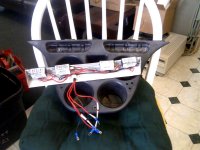
Here's the front.
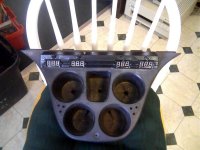
Here's the meters all working. Left to right they read: 12.2, 12.0, 12.3, 12.2
It's really not a good photo because my cell phone couldn't find the right focus.
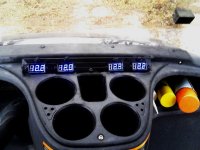
Here is the overall charge state meter for the batteries. The cart didn't come with this meter. I added it before I gave it to my brother.
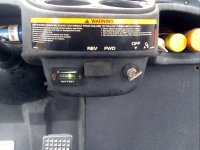
Finally, here's the cargo bed and SMV sign I rigged. I got the bed from
BuggyWorx.com They are great people and very responsive. When I reported that two bolts in their kit were too short, they called to say I was correct and they were changing their kit. The bed was ordered off of their eBay store and arrived within a about 5 days.






